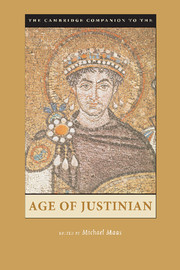Book contents
- Frontmatter
- Part 1 Structures and Ideologies of Empire
- 1 Roman Questions, Byzantine Answers
- 2 Economy and Administration
- 3 Justinian’s Constantinople
- 4 The Classical City in the Sixth Century
- 5 The Empire at War
- 6 Mediterranean Plague in the Age of Justinian
- 7 Law and Legal Practice in the Age of Justinian
- 8 Justinianic Ideology and the Power of the Past
- Part 2 Religion and Philosophy
- Part 3 Literature and the Arts
- Part 4 Peoples and Communities
- Bibliography
- Index
- Plate Section 1
- Plate Section 2
6 - Mediterranean Plague in the Age of Justinian
from Part 1 - Structures and Ideologies of Empire
Published online by Cambridge University Press: 28 May 2006
- Frontmatter
- Part 1 Structures and Ideologies of Empire
- 1 Roman Questions, Byzantine Answers
- 2 Economy and Administration
- 3 Justinian’s Constantinople
- 4 The Classical City in the Sixth Century
- 5 The Empire at War
- 6 Mediterranean Plague in the Age of Justinian
- 7 Law and Legal Practice in the Age of Justinian
- 8 Justinianic Ideology and the Power of the Past
- Part 2 Religion and Philosophy
- Part 3 Literature and the Arts
- Part 4 Peoples and Communities
- Bibliography
- Index
- Plate Section 1
- Plate Section 2
Summary
During these times there was a pestilence, by which the whole human race came near to being annihilated.
– Procopius,Wars, 2.22.1, trans. DewingVery occasionally the emperor Justinian deserves our sympathy. Epidemics are usually named after their victims: the biblical plague of the Philistines, for example, or the plague of Athens famously described by Thucydides. Yet the pandemic (worldwide epidemic) that struck the empire on an unprecedented scale during Justinian’s reign, spreading to northern and western Europe, many parts of the Middle East, and possibly China, has always been treated differently. In the Secret History Procopius blamed the emperor’s demonic machinations for all the natural disasters of his reign. Even though Justinian himself contracted the disease and its ravages long outlasted him, historians of the sixth century, following Procopius’s lead, have written of “the plague of Justinian.” This is unfair. In what follows attention will be confined for the most part to plague in sixth-century Byzantium. But the phenomenon is far larger, and to convey its “global” impact, extensive chronology, and questionable biological identity, I shall refer to it more neutrally as the early medieval pandemic (EMP).
Itineraries
There had doubtless been localized epidemics aplenty in the later Roman and the early Byzantine empires. Yet, when the EMP arrived in 541, there had apparently not been a major one since the 520s. Looking back to approximately a century before his own time, the author of the Paschal (Easter) Chronicle recorded a Great Death under the year 529, which may well be a mistaken reference to the EMP. Much later on, though more plausibly, the tenth-century universal chronicler Agapius of Hierapolis mentions a “terrible epidemic” that broke out in 525–526 and lasted for six years.
- Type
- Chapter
- Information
- The Cambridge Companion to the Age of Justinian , pp. 134 - 160Publisher: Cambridge University PressPrint publication year: 2005
- 19
- Cited by



